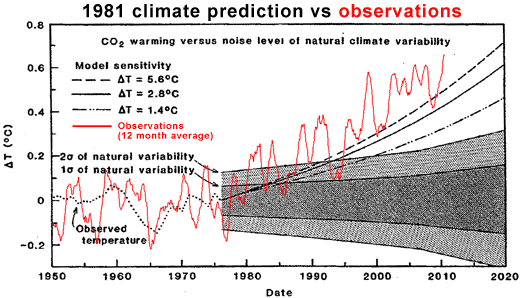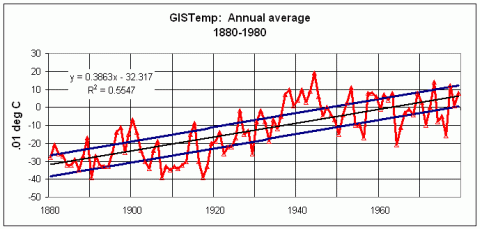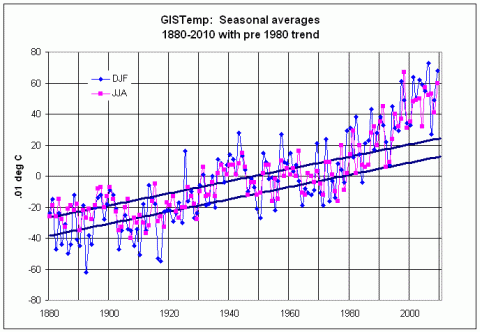Hansen etal hit a Climate Home Run -- in 1981
Posted on 24 August 2010 by muoncounter
Guest post by muoncounter
By nature, science is a prediction business. We analyze what data we have available up to a given time and then we say: Here is what will happen if ... It is risky. The bad news is that everybody will pounce on our failures. So we need to look back every once in a while and celebrate one that was right.
In August 1981, Hansen, Johnson, Lacis, Lebedeff, Lee, Rind and Russell published a paper in Science entitled Climate impact of increasing atmospheric carbon dioxide, making the following predictions:
It is shown that the anthropogenic carbon dioxide warming should emerge from the noise level of natural climate variability by the end of the century, and there is a high probability of warming in the 1980s.
The predicted CO2 warming rises out of the 1sigma noise level in the 1980s and the 2sigma noise level in the 1990s (Fig 7). This is independent of the climate models equilibrium sensitivity for the range of the likely values, 1.4 to 5.6 deg C. Furthermore, it does not depend on the scenario for atmospheric CO2 growth, because the amounts of CO2 do not differ substantially until after 2000.
Nominal confidence in the CO2 theory will reach ~85 percent when the temperature rises through 1sigma and ~98 percent when it exceeds 2sigma.
The paper went on to forecast several effects of this warming:
- Accelerated surface warming in the Arctic,
- Global shifts in climate patterns (pronounced droughts in some areas and floods in others),
- Longer agricultural seasons
The authors were somewhat hesitant to predict ice sheet melting and concomitant sea level rise, based on what they perceived was uncertainty in the thermal response time of large ice masses. However, they mention that Arctic melting will result in the opening of both Northwest and Northeast passages and a partially ice-free Arctic. This modest recommendation was made:
... the degree of warming will depend strongly on the energy growth rate and choice of fuels for the next century. Thus CO2 effects on climate may make full exploitation of coal resources undesirable. An appropriate strategy may be to encourage energy conservation and develop alternative energy sources, while using fossil fuels as necessary during the next few decades.
The following figure is the papers figure 7, shown with a plot of smoothed GISSTemp anomalies through 2010 as an overlay.

Note that the 1981 forecast was on the conservative side!
I attempted to recreate what was known at the time in the next figure, showing GISSTemp annual temperature anomalies through 1980. A straight line trend is used to form a trend line and an envelope for the noise.

In the final figure, this noise envelope is projected on the seasonal (summer and winter) GISSTemp record through July 2010.

It is clear that the warming trend predicted in the paper was already underway by 1980 -- and that is why the predicted warming of Hansen's Figure 7 was a conservative estimate.
Note: a subsequent Hansen paper (1988) was critically reviewed here. Much was made of the CO2 growth rate used in the models; 1.5 ppm per year seemed excessive at the time. The growth rate today is more than 2ppm per year. Guess we should have been paying closer attention.































 Arguments
Arguments






























There's no plan to write basic versions of every blog post. We're only writing basic versions of the rebuttals of skeptic arguments. Fair point though, even intermediate posts should explain the technical terminology.
The greenhouse effect has been directly measured for 50 years. Planes measuring the upward spectrum from 20km up find big "bites" taken out of outgoing radiation by greenhouse gases. This is confirmed by surface measurements that find corresponding extra radiation returning to Earth at those same greenhouse gas wavelengths:
Of course, you might be asking about the increased greenhouse effect. Eg - is rising CO2 levels causing an increase in the greenhouse effect and hence causing global warming. This is also directly observed by independent measuring systems: both satellites and surface measurements find less infrared radiation escaping to space and more radiation returning to Earth.
Change in spectrum from 1970 to 1996 due to trace gases.